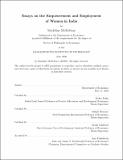Essays on the empowerment and employment of women in India
Author(s)
McKelway, Madeline.
Download1193028723-MIT.pdf (9.936Mb)
Other Contributors
Massachusetts Institute of Technology. Department of Economics.
Advisor
Esther Duflo, Abhijit Banerjee, and Frank Schilbach.
Terms of use
Metadata
Show full item recordAbstract
This thesis consists of three papers on the empowerment and employment of women in India. India's female labor force participation rate is among the lowest in the world. Research suggests many women in India want to work, husbands' opposition to their work is a key constraint, and husbands can be persuaded that their wives should work. But if women want to work and their husbands can be persuaded, why do women not persuade them? The first paper (chapter one) argues that doing so requires a general sense of self-confidence that is lacking amongst women in India. My experiment offered women in rural Uttar Pradesh a psychosocial intervention to raise generalized self-efficacy (GSE), or beliefs in own ability to attain desired outcomes. The intervention produced a persistent gain in GSE. I cross-randomized a short video promotion of women's employment for women's families. The promotion given alone increased short-run employment, which implies families in this setting can be persuaded. The GSE intervention on its own also raised short-run employment, and data suggest a key channel was giving women confidence to persuade their families. Shortrun employment under both interventions was no higher and may have been lower than under either alone. I find no effects on long-run employment, suggesting it is harder to persuade families that women should stay in the workplace than enter it. The second paper (chapter two), which is co-authored with Matt Lowe, outlines a model of household decision-making about women's labor supply and presents results from an experiment in India that tested it. The key feature of the model is that households choose whether to engage in costly bargaining about the labor supply decision. Moreover, information about women's employment opportunities may be asymmetric. Spouses choose whether to share information and whether to bargain based on their preferences for women's employment. This model has support in recent empirical research. Our experiment was set in rural Uttar Pradesh. We document misalignment of spousal preferences about women's work in this setting: wives are significantly more supportive of women's employment than their husbands. We experimentally varied enforcement of common knowledge and enforcement of bargaining. We randomized whether husbands or wives were given information about a women's job opportunity and an enrollment ticket. We cross-randomized whether nontargeted spouses were not informed, informed separately, or informed at the same time as their targeted spouses. In the third condition, we explicitly encouraged discussion with the view of enforcing bargaining. Surprisingly, we find that husbands did not withhold information and that discussion significantly decreased enrollment. Our results contradict the standard predictions outlined in the model. The final paper (chapter three) explores the effects of women's employment. A standard prediction of the household literature is that women's employment should increase women's intra-household bargaining power. This paper provides the first experimental tests of this prediction. The experiment was conducted in rural Uttar Pradesh, a setting where women's family members typically decide whether women work. The intervention is the promotion intervention used in the first paper, a video promoting a women's employment opportunity that was designed to address family members' key objections to women working. I informed both treatment and control family members about the opportunity but only showed the promotion to treatment family members. The promotion led to large increases in women's employment and is unlikely to have affected other family outcomes through channels aside from women's employment; I interpret effects of the promotion on these outcomes as effects of women's employment. I find employment enabled women to make more decisions independently and without their husbands' knowledge. However, it did not increase their bargaining power in joint decisions. My results are inconsistent with the standard collective model of the household and more aligned with a model in which spouses do not fully pool their incomes.
Description
Thesis: Ph. D., Massachusetts Institute of Technology, Department of Economics, May, 2020 Cataloged from the official PDF of thesis. Includes bibliographical references.
Date issued
2020Department
Massachusetts Institute of Technology. Department of EconomicsPublisher
Massachusetts Institute of Technology
Keywords
Economics.